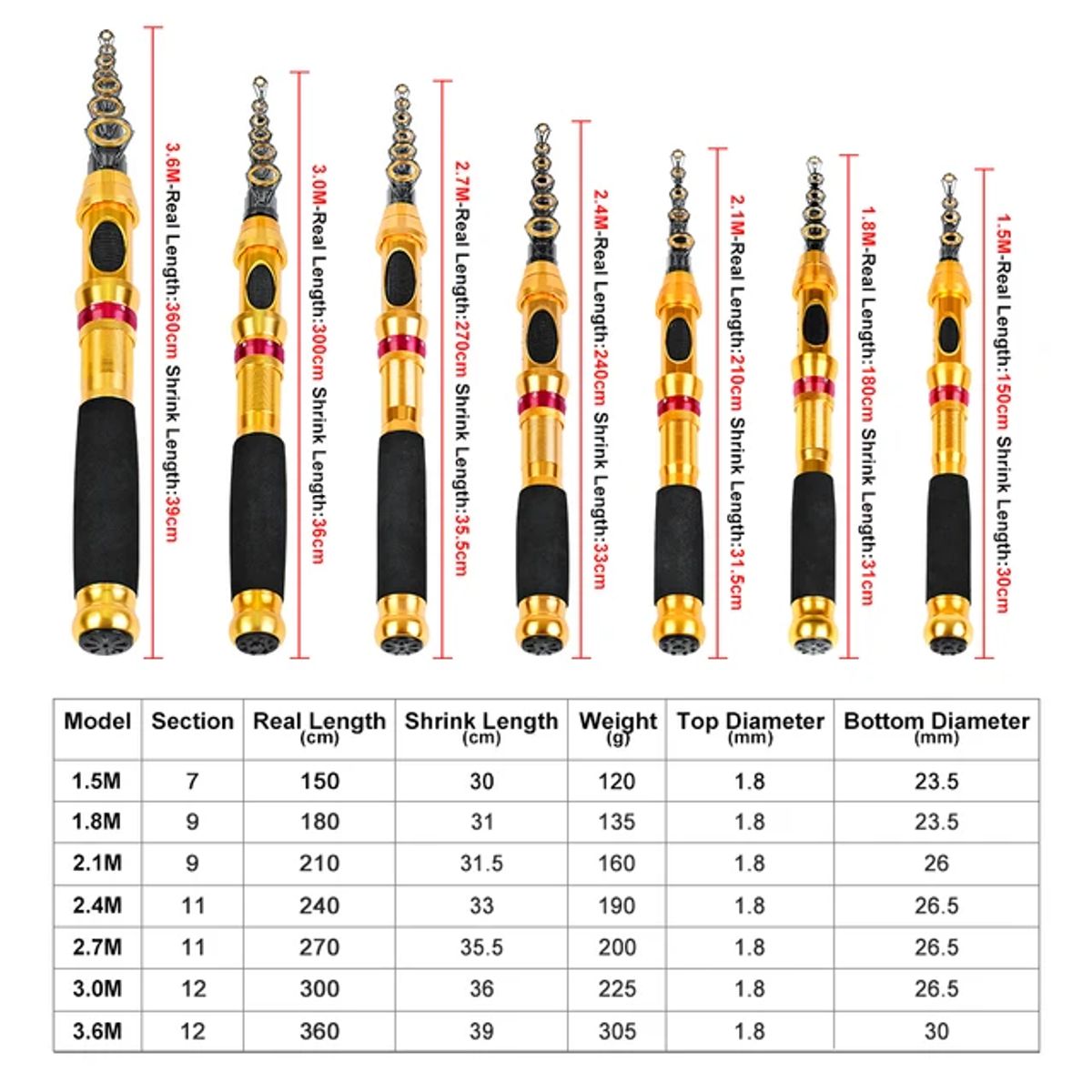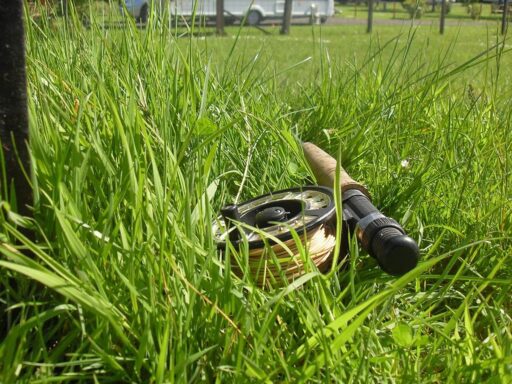Fly fishing is an art that requires not just skill but also the right equipment. A crucial part of this equipment is the fly fishing rod, which comes in various sizes and characteristics tailored to different fishing conditions and species. Understanding how to decipher fly fishing rod sizes and matching them with the appropriate reels is essential for both novice and experienced anglers. This guide provides insight into selecting the right fly rod and reel, ensuring a harmonious balance for an optimal angling experience.
Key Takeaways
- The right fly rod enhances angling success, influencing casting precision and the overall enjoyment of the fishing experience.
- Rod length and weight directly affect casting ability and the size of fish that can be managed, with 9 feet being a standard length for freshwater.
- Matching rod weight to reel size is crucial for balance and comfort during casting, with reel sizes denoted by numbers like 3/4, 5/6, or 7/8.
- Understanding the drag system of a reel is important for efficient fish handling, ensuring smooth resistance during the fight with a fish.
- Emerging trends in fly rod technology and the option for custom setups allow anglers to fine-tune their gear for targeted fishing scenarios.
The Importance of Choosing the Right Fly Rod

Understanding the Role of the Fly Rod in Angling Success
The fly rod serves as the angler’s primary interface with the water, a critical factor in the success of fly fishing. The right fly rod can enhance both the precision of the cast and the enjoyment of the sport. It’s a balance of strength to battle fish and flexibility for delicate presentations.
- Strength: Essential for controlling and landing fish.
- Flexibility: Allows for accurate and graceful fly casting.
- Length: Dictates casting distance and maneuverability.
The synergy between angler and rod is paramount; a well-chosen rod becomes an extension of the angler’s intent, translating subtle movements into effective actions.
Understanding the nuances of fly rod selection is not just about technical specifications; it’s about finding a rod that feels right in your hands and suits your fishing style. Whether you’re navigating narrow streams or open waters, the rod you choose is your partner in the pursuit of fly fishing excellence.
The Impact of Rod Selection on Casting and Catching
Selecting the right fly rod is a pivotal decision that affects both casting ability and the success of catching fish. A light and balanced rod is critical for best performance, ensuring that each cast is both accurate and efficient. The sensitivity of the rod is equally important, as anglers rely on the subtlest of vibrations to detect strikes and react promptly.
When considering rod selection, it’s essential to match the rod with the appropriate reel to achieve a harmonious balance. This synergy allows the rod to feel like an extension of the angler’s arm, which is crucial for long days on the water. Here are some key points to keep in mind:
- Balance is key when pairing rods and reels.
- Overall weight and aesthetics should be considered.
- Anticipate specific fishing conditions.
The choice of a fly rod can make or break the fishing experience, influencing not just the ability to catch fish, but also the enjoyment of the casting process itself.
Remember, while less expensive rods may be appealing, they often come at the cost of heavier weight and lower quality components, which can diminish sensitivity and overall fishing enjoyment. As the adage goes, investing in the best gear within your budget is a wise decision for any serious angler.
Balancing Personal Preference with Rod Specifications
When selecting a fly fishing rod, the balance between personal preference and the rod’s technical specifications is crucial. A well-matched rod and reel will feel like an extension of your arm, enhancing your casting precision and sensitivity to fish activity. It’s important to consider not only the weight and balance of the rod but also how it aligns with your fishing style and the environments you’ll be fishing in.
- Rod sensitivity is a key factor, as it affects your ability to detect strikes.
- The overall aesthetics of the rod can also influence your choice, contributing to the enjoyment of the sport.
- Anticipating the specific fishing conditions you’ll encounter helps in selecting the right rod weight and action.
Crafting a rod that suits your personal needs can be a rewarding process. While it may be time-consuming, following guidelines ensures a satisfying outcome that aligns with your preferences for fishing various sizes of fish and different environments.
Remember, the goal is to find a rod that not only meets the technical demands of fly fishing but also brings you joy and confidence on the water. Whether you’re crafting your own rod or choosing from available options, take the time to weigh all factors for a harmonious fishing experience.
Understanding Fly Rod Characteristics

Decoding Rod Length and Its Effects on Fishing
The length of a fly rod is a pivotal factor in its performance. Shorter rods, typically ranging from 7 to 8 feet, are excellent for tight spaces and provide superior control when precision is necessary. On the other hand, longer rods, which can extend up to 10 feet, offer increased reach and leverage, essential for covering more water and handling larger fish.
The choice of rod length is not just about personal comfort; it’s about maximizing efficiency and effectiveness on the water.
Rod length also influences the type of water you’re fishing in. For instance, a 9-foot rod is considered versatile and is the standard for most freshwater applications. However, if you’re fishing in a region with easy access to various river sections, like the Rocky Mountain region, a 10-foot rod paired with a car-top rod carrier might be the ideal setup for quick transitions.
Here’s a quick reference for selecting rod length:
- 7 feet: Small streams, tight cover
- 8 feet: General freshwater, some open areas
- 9 feet: Versatile, standard freshwater
- 10 feet: Large waters, better drifts, added reach
Navigating Through Rod Weights for Optimal Performance
Choosing the correct fly rod weight is essential for achieving the best performance on the water. Rod weight determines the line weight it is designed to cast, and thus directly influences your casting accuracy and the size of the fish you can effectively catch. Here’s a quick guide to understanding rod weights:
- 1-3 weight rods: Ideal for small streams and delicate presentations.
- 4-6 weight rods: Versatile for various freshwater scenarios.
- 7-8 weight rods: Suitable for larger freshwater fish and light saltwater use.
- 9+ weight rods: Designed for big game and heavy saltwater fishing.
A light and balanced rod is critical for best performance. It’s important to match the rod weight to the expected fishing conditions and the species you are targeting.
When considering rod weight, also think about the balance with your reel. A well-matched rod and reel combo will feel like an extension of your arm, enhancing your casting experience and sensitivity to strikes. Remember, the goal is to create a harmonious setup that allows you to cast effortlessly and detect even the subtlest of bites.
Grasping the Significance of Rod Action in Fly Fishing
The action of a fly rod is a critical aspect that influences the angler’s casting abilities and the overall fishing experience. Fast-action rods are designed to bend primarily near the tip, which allows for greater power and distance, especially in windy conditions or when fishing in larger bodies of water. These rods are often favored by anglers who need to make long casts or who are targeting larger fish.
Medium-action rods offer a compromise, flexing through the midsection. This balance of power and precision makes them suitable for a variety of fishing conditions and is often recommended for those who enjoy diverse fishing experiences.
Slow-action rods are known for their deep flex into the butt of the rod, making them the ideal choice for short, precise casts. They shine in small streams where delicate presentations are paramount.
Understanding the nuances of rod action can greatly enhance your fly fishing technique and success. Here’s a quick reference to summarize the characteristics:
- Fast-Action: Power and distance, less precision
- Medium-Action: Balanced power and precision, versatile
- Slow-Action: Precision for short casts, ideal for delicate presentations
The Synergy of Rod and Reel: Building a Cohesive Fly Fishing System

Matching Reel Size and Weight to Your Fly Rod
Achieving the perfect balance between your fly rod and reel is crucial for an optimal fishing experience. The reel size should match the weight of your rod and line, ensuring a balanced outfit that enhances casting accuracy and reduces fatigue during a long day of fishing. Reels are typically sized by line weight, and it’s important to avoid choosing a reel that is too heavy or too light for your rod.
A well-matched rod and reel set will feel like an extension of your arm, allowing for effortless casting and increased sensitivity to strikes.
When selecting a reel, consider not only the balance but also the aesthetics and the specific fishing conditions you anticipate encountering. Reels tend to be slightly oversized to compensate for the longer rod lengths, which helps to balance the fly rod comfortably in your hand. Below is a simplified guide to help you match reel sizes to common fly rod weights:
| Rod Weight | Reel Size Range |
|---|---|
| 1-3 | Super ultralight |
| 4-5 | Ultralight |
| 6-7 | Light to medium |
| 8-9 | Medium to heavy |
| 10+ | Heavy |
Remember, the goal is to strike a proper balance that guarantees more comfortable casts, especially when angling over an extended period. Always check your fly fishing reel size before everything else to ensure it falls within the range you need.
Evaluating Drag Systems for Efficient Fish Handling
The drag system of a fly reel is a critical component for efficient fish handling. It provides the necessary resistance to a fish’s pull, preventing line backlash and spool overrun. There are two primary types of drag systems to consider: disc drag and click-and-pawl.
- Disc Drag Systems are renowned for their adjustability and smooth start-up, which is essential for maintaining consistent pressure on the fish and protecting light tippets. They are particularly useful when targeting larger fish that require more stopping power.
- Click-and-Pawl Systems offer a simpler mechanism with a classic feel. They provide sufficient resistance for smaller fish and are favored by those who appreciate the traditional aspects of fly fishing.
When selecting a drag system, it’s important to balance the need for control with the type of fishing you’ll be doing. A well-chosen drag system can make the difference between a successful catch and a lost fish.
Remember, the reel size should match the weight of your rod and line to ensure a balanced setup. This harmony between rod, reel, and line weight is pivotal for casting precision and reducing fatigue during a long day of angling.
Considering Material and Durability for Long-Term Use
When it comes to the longevity of your fly fishing gear, the material of the reel is a pivotal factor. Machined aluminum reels stand out for their durability and corrosion resistance, making them an excellent choice for the harsh conditions of saltwater fishing. On the other hand, graphite reels offer a lighter option that is cost-effective and well-suited for freshwater environments and those just starting out in fly fishing.
The synergy between the strength, flexibility, and lightness of materials like carbon fiber and titanium is crucial. These advanced materials not only reduce the overall weight of the reel but also enhance its corrosion resistance, providing a practical advantage for anglers.
Understanding the mechanics behind rod and reel failure is essential. The design and materials used can significantly influence the performance and lifespan of your equipment. Pioneers in the industry have long emphasized the importance of material science in the development of future innovations, ensuring that practicality prevails over aesthetics.
Here are some popular materials used in custom rod building and their characteristics:
- Graphite: Known for its sensitivity and lightweight, ideal for detecting subtle bites.
- Carbon Fiber: Offers a blend of strength and flexibility, often used in higher-end rods.
- Titanium Components: Provide exceptional strength and corrosion resistance, suitable for various rod classes.
Advanced Considerations for the Avid Angler

Exploring Specialty Rods for Targeted Fishing Scenarios
When venturing into specific fishing scenarios, the selection of a specialty rod can be the difference between a good day on the water and a great one. Understanding the nuances of each fishing environment is crucial to choosing a rod that will enhance your experience and success rate. For instance, stalking trout in clear mountain streams requires a different approach than casting for tarpon on windy saltwater flats.
Specialty rods are designed with particular species and environments in mind, offering features that standard rods may not provide. This targeted approach can significantly improve your angling precision and efficiency.
Here’s a quick overview of considerations for some popular fishing scenarios:
- Mountain Streams: Look for a rod with high sensitivity and light weight to detect subtle strikes.
- Saltwater Flats: A rod with more power and durability to handle windy conditions and larger fish.
- Stillwater: Choose a rod that can deliver a variety of fly lines, from floating to sinking, to adapt to different depths and fish behaviors.
Remember, while the initial investment in a specialty rod may be higher, the payoff in tailored performance is often worth the cost.
The Art of Customizing Your Fly Fishing Setup
Customizing your fly fishing setup is not just about aesthetics; it’s about creating a rod that feels like an extension of your arm. The handle and grip are tailored to provide optimal comfort and control, ensuring that every cast is as intuitive and effective as possible. Custom rod builders take pride in their work, often expressing their artistry through intricate thread wraps and color patterns.
Investing in a custom fishing rod is a testament to an angler’s dedication to the sport. It’s a pursuit that combines expertise, artistry, and innovation to create a rod that’s uniquely yours.
The finishing touches on a custom rod are just as important as the initial build. Applying finish to a rod not only gives it a polished appearance but also ensures the durability of the thread wraps and components. This process requires precision and attention to detail to achieve a flawless result. Here’s a quick overview of the customization process:
- Selection of quality materials
- Determination of the desired action and length
- Custom wrapping to reflect the angler’s style
- Application of a durable and aesthetic finish
By customizing your fly fishing setup, you engage in a creative process that enhances your connection to the sport and the tools you use.
Staying Ahead: Emerging Trends in Fly Rod Technology
As the fly fishing industry evolves, staying informed about the latest advancements in rod technology is crucial for the avid angler. Innovations in materials and design are leading to lighter, stronger, and more responsive rods, enhancing the fishing experience and success rate.
Emerging trends include the integration of new materials such as advanced carbon fibers, which offer improved strength-to-weight ratios. Companies like Echo have made strides in making durable rods at competitive prices, while Orvis’s 4th generation Helios fly rod showcases the pinnacle of current rod technology.
- Advanced carbon fiber technology
- Improved rod strength and sensitivity
- Focus on affordability without sacrificing quality
The synergy between technological advancements and practical angling needs is shaping the future of fly fishing, making it an exciting time to be part of this sport.
Practical Tips for Matching Fly Rods and Reels

Step-by-Step Guide to Aligning Rod Weight with Reel Size
Achieving the perfect balance between your fly rod and reel is crucial for an optimal fishing experience. The reel size should match the weight of your rod and line, ensuring a balanced outfit that feels like an extension of your arm. This harmony allows for effortless casting and increased sensitivity to strikes.
- Firstly, verify that the reel size is appropriate for the rod weight. Reels are typically sized by line weight, and a mismatch can lead to casting inaccuracies and unnecessary fatigue.
- Secondly, consider the overall weight of the rod and reel together. The aesthetics and the specific fishing conditions you anticipate should also influence your choice.
- Lastly, always check the drag system of the reel to ensure it provides smooth and reliable control when fighting fish.
Selecting the right reel to complement your fly rod is equally important. It not only holds the line but also contributes to the balance of the rod, enhancing casting and handling.
Troubleshooting Common Issues in Rod and Reel Compatibility
Ensuring that your fly rod and reel are compatible is crucial for a successful fishing experience. Balance is the cornerstone of a well-matched rod and reel combination, providing the angler with comfort and precision during casting. Here are some common issues and how to address them:
- Imbalance: If the rod and reel feel unbalanced, check the weight specifications of both. They should be closely matched to maintain the rod’s center of gravity.
- Poor Casting: Difficulty in casting may be due to mismatched rod action and reel weight. Ensure that the reel’s weight complements the rod’s action for smoother casts.
- Line Retrieval Issues: If the line doesn’t retrieve smoothly, the reel’s drag system may not be properly aligned with the rod’s capabilities. Adjust the drag or consider a reel with a better-suited drag system.
When troubleshooting, always start by examining the reel size and weight. A reel that’s too heavy or too light can throw off the entire dynamic of your fly fishing setup, leading to fatigue and reduced sensitivity to fish activity.
Remember, the goal is to create a harmonious setup where the rod and reel work together seamlessly. If issues persist, consult with a professional or refer to the manufacturer’s guidelines for further assistance.
Expert Advice for Fine-Tuning Your Fly Fishing Gear
When fine-tuning your fly fishing gear, it’s essential to consider not only the compatibility of rods and reels but also the subtleties that can make or break your fishing experience. Expert anglers often emphasize the importance of a balanced setup where the rod, reel, and line work in harmony, providing the precision and control needed for effective casting and retrieving.
Fine-tuning your gear is an ongoing process that involves assessing performance on the water and making incremental adjustments. This hands-on approach ensures that your equipment is tailored to your specific fishing conditions and techniques.
Here are some expert tips for optimizing your fly fishing setup:
- Experiment with different line weights to find the best match for your rod and reel.
- Pay attention to the balance point of your rod when the reel is attached; it should feel comfortable and natural in your hand.
- Regularly clean and maintain your reel’s drag system to ensure smooth operation.
- Consider the type of fishing you’ll be doing and select gear that is appropriate for those conditions.
Remember, the goal is to create a cohesive system where each component complements the others, resulting in a more enjoyable and successful angling experience.
Conclusion
In summary, the journey to mastering fly fishing begins with selecting the appropriate rod size, which is pivotal for a successful and enjoyable angling experience. The length, weight, and action of a fly rod are crucial characteristics that determine its suitability for different fishing conditions and target species. Anglers must consider these factors in conjunction with the matching reel size and drag system to achieve a harmonious balance in their fishing gear. By investing the time to understand and choose the right equipment, both novice and seasoned fishermen can enhance their performance on the water, making every cast count and every catch memorable. Remember, the right fly fishing rod is not just a tool; it’s an extension of the angler’s intent and skill, and the key to unlocking the full potential of their fly fishing adventures.
Frequently Asked Questions
How does rod length affect my fly fishing experience?
The length of a fly rod influences casting ability, the size of fish you can handle, and suitability for different types of water. Shorter rods offer better control in tight spaces, while longer rods provide more reach and leverage for casting and battling larger fish.
What does rod weight indicate in fly fishing?
Rod weight denotes the weight of the fly line that a rod is designed to cast efficiently. Lighter weights (1 to 3) are for small streams and delicate presentations, mid-range weights (4 to 6) are versatile for various freshwater scenarios, and heavier weights (7 and above) are for larger fish and saltwater environments.
How do I match my fly reel size to my rod weight?
Match the reel size to the rod weight by ensuring the fly reel can handle the corresponding line weight. For example, a 3/4 fly reel is suited for lines within the 4 to 5 weight range, while a 5/6 reel is appropriate for lines within the 5 to 6 weight range.
Why is it important to consider the drag system when selecting a fly reel?
A good drag system is essential for efficient fish handling, as it helps to apply the right amount of resistance to a hooked fish, preventing the line from breaking and allowing for smoother reeling in of the fish.
What factors should I consider for the durability of my fly fishing gear?
When considering durability, look at the materials of both the rod and reel, the construction quality, and the resistance to corrosion, especially if fishing in saltwater. High-quality materials and construction will ensure long-term use and reliability.
What are the emerging trends in fly rod technology that I should be aware of?
Emerging trends include advancements in materials that offer a better strength-to-weight ratio, improvements in rod action for more precise casting, and the integration of technology for enhanced performance and feedback during fishing.





